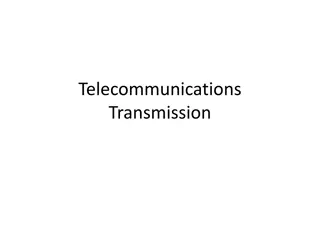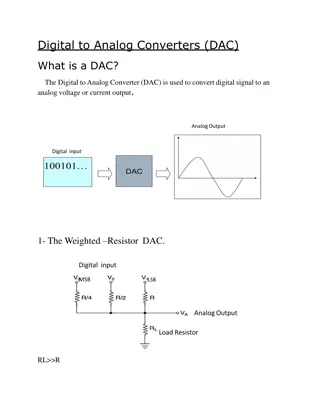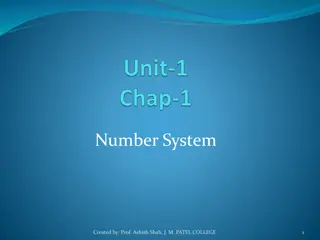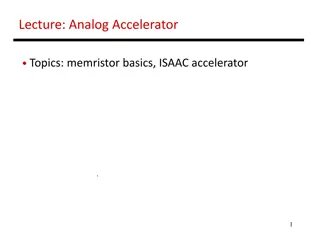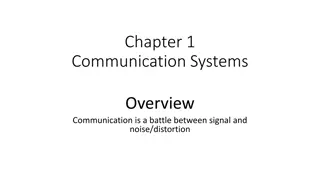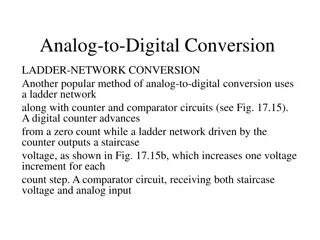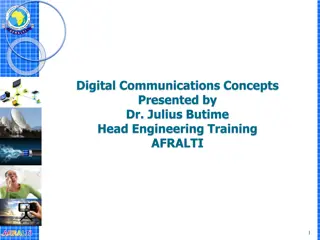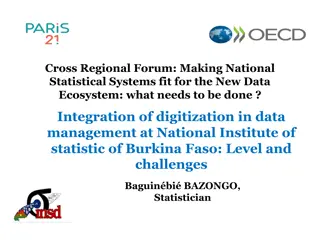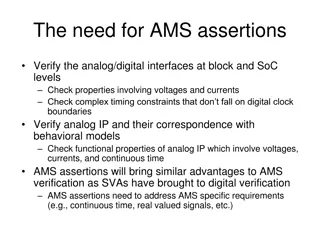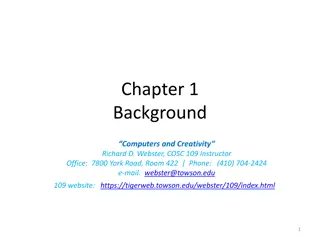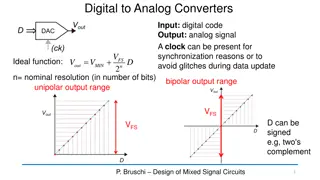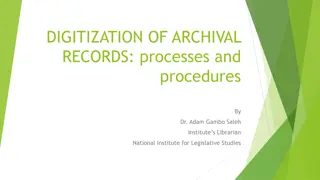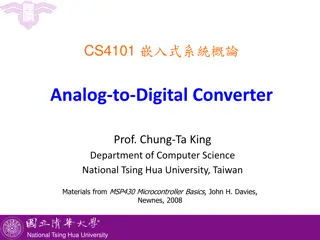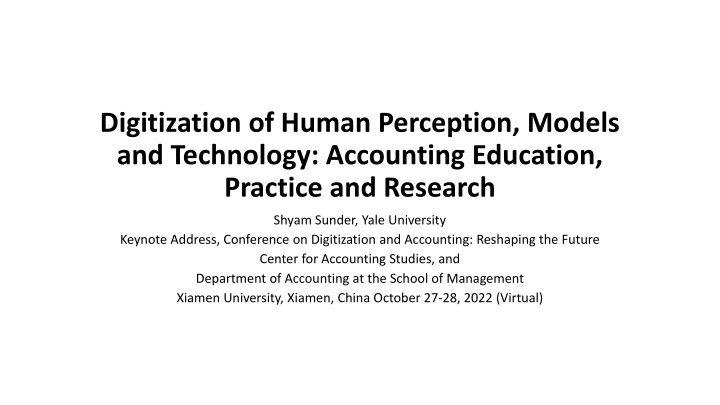
Digitization of Human Perception: From Analog to Digital Development
Prospects weren't bright for digitization initially, yet it has been a spectacular success, altering our perception and enabling civilization. Explore the transition from analog to combined analog-digital perception of the environment.
Download Presentation

Please find below an Image/Link to download the presentation.
The content on the website is provided AS IS for your information and personal use only. It may not be sold, licensed, or shared on other websites without obtaining consent from the author. If you encounter any issues during the download, it is possible that the publisher has removed the file from their server.
You are allowed to download the files provided on this website for personal or commercial use, subject to the condition that they are used lawfully. All files are the property of their respective owners.
The content on the website is provided AS IS for your information and personal use only. It may not be sold, licensed, or shared on other websites without obtaining consent from the author.
E N D
Presentation Transcript
Digitization of Human Perception, Models and Technology: Accounting Education, Practice and Research Shyam Sunder, Yale University Keynote Address, Conference on Digitization and Accounting: Reshaping the Future Center for Accounting Studies, and Department of Accounting at the School of Management Xiamen University, Xiamen, China October 27-28, 2022 (Virtual)
An Overview Development of Human perception: from analog to digital Possibly distinguished genus homo from its predecessors Prospects were not bright: digitization discards information Yet, surprisingly, digitization has been a spectacular success Why? Digitization has altered our perception and cognition, and enabled civilization Accounting Practice and regulation with illusion of digital power Conclusion: shaping the future of accounting?
Development of Human perception: from analog to digital
Perception is Analog Numbers and counting have become such in integral part of life of most adults in the world that we are hardly aware that there is nothing natural about them. Our five sensory perceptions vision, hearing, smell, taste and touch manifest themselves in analog, not digital forms. These sensory perceptions, and their analog nature, is common among most mammals, and at least some of them are common to other life forms too. Early hominids (ancestors of us homo sapiens) perceived their environment almost entirely in analog forms. Analog sensory magnitudes exist only in ordinal forms (e.g. star X is brighter than start Y), and not cardinal forms (e.g., star X is twice as bright as star Y) It is probably also largely true of humans who grow up in non-numerate tribal societies (e.g., the number of children in a family: one, two, three, four, and many) The ability of untutored humans and animals, including insects, to perceive and compare magnitudes (e.g., a basket with 20 apples has more than basket with 15), and respond to them should not necessarily be interpreted as ability to count
Digital Dawn In distant past, perhaps 200 to 50 thousand years ago, humans transitioned from analog alone to combined analog-digital perception of their environment It is likely that the initial objects of newly acquired digital perception were people, animals and trees whose discreteness was directly perceived We do not know when the distinction between smaller and larger sets (of people, animals or trees) came to be concretized in the form of differences between their numerosity (long before numbers were conceived of) Perhaps physical aids and supplements to memory played a key step towards this development of our faculties
Early Aids to Memory Fingers of hand Tally marks on cave walls Tally marks on bones and wood (Lebombo bone from Africa, about 44,000 BCE) Strings and knots
Symbolic Representation Recognizing each discrete object and event, and recording it in some physical form (such as a line on the wall for each) requires symbolic representation For example, each mark may represent one animal, or one sunrise This symbolic representation of one object or event by another was a huge leap of abstraction, and advancement in human faculties Few other life forms are known to possess this faculty A great deal of what distinguishes us humans from all other life forms involves symbolic representation and manipulation Numbers, gestures, language, and art are consequences of development of this faculty
Rise of Numbers Symbols themselves are not numbers, and their use does not necessarily amount to counting Numbers are a special kind of symbols that demand a high level of abstraction beyond usual symbols (e.g., representing an animal by a line on the wall) Let us think a little about the concept and meaning of numbers A set of animals represented by a set of chalk marks on the wall A set of trees represented by a set of chalk marks on the wall A set of children represented by a set of chalk markets on the wall
What is two? Every school child understands and uses numbers one, two, three But let us ask ourselves as adults: what is two ? Typical response two apples , two oranges , two cars does not really answer the question being asked. Twoness is an abstract property shared by the three abovementioned sets of objects (animals, trees, children) or symbols, as well as innumerable other sets. Imagine the day when a caveman, perhaps some 100 or 50 thousand years ago may have realized that two tally marks each on the wall for the deer he hunted, and stone tools he made, arrows he lost, have something in common. That common property of three sets is their twoness , an idea of a high order of abstraction. Then came the ideas of oneness , threeness , etc. of sets The amazing aspect of this idea is that it is applicable to anything perceived in discrete units Our distant hunter-gatherer ancestor was interested in real things, but his invention of numerosity had revolutionary consequences for his life, his brain, and for us.
NumeralsLabels for Diverse Sets of Objects of a Given Numerosity At some point of time subsequent to becoming aware of common numerosity of sets (two deer and two trees), human beings must have created labels for each level of numerosity Sets sharing the twoness property came to have a label two , and similarly for other levels of numerosity. These labels probably took the form of sounds at first, which may have been converted to written markings Today, we do not know what these early markings were, but we do have evidence of markings from early history of China, India, Mesopotamia and Mayan as well as many other civilizations
Fig.1: Wood and stones carvings. (Ifrah and Bello198). Written Numerals
Digitization May Distinguish Genus Homo? Evolution of digital concepts and faculties was a major step in development of human brain Digitalization required: Classification of objects into categories (persons, animals, trees) and sub- categories (children, men, women), etc. It led to keeping a tally (marks on walls, wood or bones), Development of numbers and counting And ultimately to development of language Each of these steps was a major accomplishment in human development
Popularity of Decimal Systems Digits means fingers We have ten fingers and ten toes, which may have been the early instruments for counting (just I learned to do in first grade) Some civilizations developed other than 10 as the basis of their number system Today, computer science uses a binary system (0-1 or on-off)
Expansion of Digitization Digitization arose from naturally discrete domains of people, animals, trees, etc. We might have thought that digitization would remain confined to things that can be counted. But for reasons we need to examine soon, it did not stop there Digitization became imperial it has expanded rapidly outside discrete domains, ignoring its natural boundaries What are examples of this imperial expansion? Why has digitization expanded to cover so much of our lives in spite of its manifest limitations?
Imperial Expansion of Digitization: Numbers Everywhere Normal human body temperature is 37 degrees Celsius Highest mountain peak is 29,032 feet A solar year has 365 days, 5 hours, 48 minutes, and 46 seconds A 100-watt incandescent electric light bulb gives out 1700 lumens of light United States gross domestic product in year 2021 was $23 trillion Inability to hear sounds below 40 dB implies mild loss of hearing And many more
Digitization Discards Information Analog magnitudes (e.g., distance, time, temperature, etc.) are inherently continuous Using numbers to represent these magnitudes calls for discretization, and rounding off by adding or discarding a small amount This means that compared to true analog magnitudes, their numerical representation almost always adds some noise Yet, digitization is everywhere; Why?
Why Is Digitization Such a Spectacular Success? Consider two critical features of our (decimal) digital system: Zero: a symbol or representation for nothing Place value: value of the same digit (symbol) becomes ten time larger as it moves one place to the left, and ten times smaller as it moves one place to the left These two features of our number system which likely spread to Europe through Arabia greatly simplified arithmetic operations using simple algorithms for addition, subtraction, multiplication and division easily learned by first and second graders today Roman numerals without these features were difficult to use in arithmetic operations It is possible that Nagarjuna s highly influential Madhyamika Buddhist or Shunyavada philosophy in the third century CE may have led mathematicians familiar with this philosophy to propose a symbol for shunya (zero)
Perception, Cognition and Civilization As more and more numbers are used to represent our direct sensory perceptions, scientific and socio-economic phenomena, our cognition has been affected by digitization Introduction of national income accounts in the first half of the twentieth century has changed how we see and deal with economic matters. Until that time, we could not know the levels and rates of change of GDP in various economic systems Most science, medicine, and engineering, and a great deal of production and logistics on which our civilization depends would not be possible without digitization However, our immediate concern in this session is more limited, and focused on accounting. Let us turn to accounting.
Digitization and Accounting Evidence from virtually all ancient civilizations Egypt, Mesopotamia, China, India, Greece as well as others--reveal accounting, especially for temples and the king s household, to be intensive users of numbers for accounting and accountability. Number of cattle, volume or weight measures of grain and other valued commodities were recorded by scribes who, almost always, had high status earned by their literacy Use of numbers to track operations, transactions, and inventory was essential for the king as well as craftsmen, traders, and businesses over the millennia Twentieth century technological innovations, mechanical followed by electronic, introduced a quantum jump in this well-established pattern of digital accounting
Accounting Practice Accounting costs which used to essentially variable (mostly costs of clerical salaries and office space, roughly proportional to number of client accounts and transactions etc.) have been transformed into fixed costs of software development and maintenance Great economies of scale in businesses where cost of accounting was a major expense (e.g., consolidation of banks, trading exchanges, index mutual funds) Real time monitoring, managerial control, and audits Artificial intelligence in auditing Business analytics (e.g., temporal and cross-sectional comparisons, forecasting, visual presentation) However, the advances in computing and communications technology speed, memory, detail, and analysis should not blind us to two fundamental aspects of accounting and symbolic representation that remain unchanged: classification and human motivation Ignoring these limitations of technology will continue to bring disappointment and grief if not properly recognized by those responsible for rules and regulations
Limitations of Classification All accounting requires us to classify objects, events and transactions into a finite set of mutually exclusive and collectively exhaustive categories Devising a scheme of classification requires us to specify the relevant attributes of objects of classification, and cut-off points for each attribute Selection of classification attributes, as well as selection of cut-off points, are not made easier by modern technologies In fact, I shall argue that greater computing power and memory may give us, unless we are careful, an illusion that technology will help solve the problem; in fact it is made worse. Let me explain why and how.
Classification in a Fractal World Our world has infinite detail No two things or transactions are exactly alike Dilemma of Uniform classification: Things with any differences should be in different classes Or, things with any similarity should be in same class Uniformity and consistency of classification by written rules in a fractal world is an impossible goal
Rule Making in Presence of Economic Motivations All rules and regulations choose certain attributes and cut-off thresholds to classify events, objects and transactions to specify recommended action People whose interests are not served well by the classification implied by the rules and regulations take one or both of two actions: Modify the relevant attribute(s) object of classification until it falls on the desired side of the cut-off point (if it can be done within reasonable costs) Add new attributes to the object of classification which are not covered by existing rules to make them inapplicable, and gain desired classification Any number of examples: lease accounting rules (more than 50 attempts in six decades), Basle I, II, III and counting in banking regulation Caused by false confidence of rule makers that digital computers give them additional power to direct what firms should do and report In fact, the effect of digital revolution is just the opposite
Limitations and Caution Power of digital revolution may give rule makers, who do not recognize the fractal character of the world, that their recommendations can be implemented better But their taxonomies for accounting (or in any other domain) are based on a finite-dimensional concept which is false Failures of XBRL, IFRS, Basle I, II, and III in achieving their stated goals is not because these organizations did not do their work right It is because they fail to comprehend the nature of the challenge before them In law, they combine statutory law with common law or equity which is a matter of social norms and community judgment, not written rules Even criminal courts make life and death decisions by social norms judgments, because they cannot be made by written rules alone. Why don t they enter the facts of each case into a computer and let it tell us if a crime has been committed (fire the judges and close the courts) Perhaps one day, accounting rule makers will also learn from their failures, understand this limitation of written rules, and not be blinded by the power of digital computers No matter how powerful our computers are, classification in a world of limitless detail cannot be done by rules, and we shall continue to need judges and accountants
Concluding Remarks Accounting is, quite likely, the first attempt by early humans to artificially construct a digital representation of their environment, first in their minds, but also in physical world of cave walls, bones, and wood. Symbolic representation of the environment required unprecedented achievements in abstraction that appears to be unique to genus homo, and their descendants Physical evidence of this incredible achievement is available in caves in many parts of the world; and we must infer the mental processes and advancements that enabled them to create these objects from surviving objects Abstraction and symbolic representation may well be the distinguishing feature of the brains of genus homo. This model of symbolic representation succeeded so spectacularly that today we often perceive many if not most aspects of our environment in digitized forms. Even continuous magnitudes, such as temperature, weight and time are often represented in digits (e.g., 37 degrees centigrade), well beyond how our bodies directly perceive objects as warm or cold, heavy or light, or soon and delayed.
Concluding Remarks In the recent century, development of digital computing and communications technology has returned the favor in form of its feedback effects on accounting education, practice and research. However, a regulators frequent misunderstanding of what is achievable by the power digital computers in a world of limitless detail through written rules has repeatedly led financial reporting into blind alleys I hope that accounting rule makers will learn from lawyers, and writers of the Oxford English Dictionary in the 19th Century: language and meaning of words is too wild to be tamed by written rules. In fact, precision of meaning destroys a natural language.
Some References Messina, Andrea; Potrich, Davide; Perrino, Matilde; Sheardown, Eva; Miletto Petrazzini, Maria Elena; Luu, Peter; Nadtochiy, Anna; Truong, Thai V.; Sovrano, Valeria Anna; Fraser, Scott E.; Brennan, Caroline H.; Vallortigara, Giorgio, "Quantity as a Fish Views It: Behavior and Neurobiology" in FRONTIERS IN NEUROANATOMY, v. 16, (2022), p. 943504.1- 943504.18. - URL: https://www.frontiersin.org/articles/10.3389/fnana.2022.943504/full . - DOI: 10.3389/fnana.2022.943504. Havil, Julian. The Irrationals: A Story of the Numbers You Cant Count on, Princeton: Princeton University Press, 2014. Print. Higgins, Peter. Number Story: From Counting to Cryptography, Gottingen: Copernicus, 2008. Print. Ifrah, Georges, and David Bello. The Universal History of Number: From Pre-history to the Invention of Computer, Hoboken: Wiley, 2000. Print. Dye, Ronald A., Jonathan Glover, and Shyam Sunder. Financial Engineering and the Arms Race Between Accounting Standard Setters and Preparers. Accounting Horizons, Vol.29, No. 2, 2015, pp. 265-295. Available at http://dx.doi.org/10.2139/ssrn.2508360.
Thank You Shyam.sunder@yale.edu https://faculty.som.yale.edu/shyamsunder/research/


